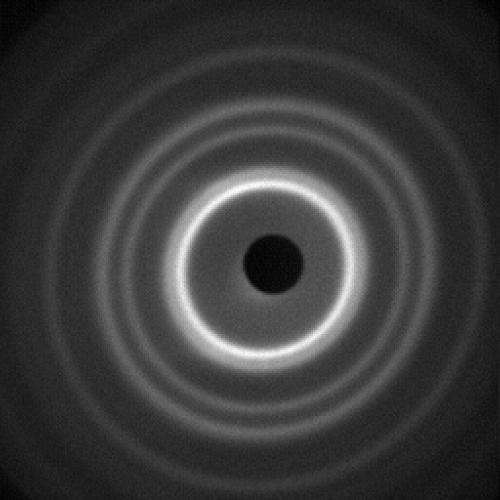STFC’s VELA accelerator. Credit: STFC
A UK lab has successfully taken images of the atomic structure of materials - at a shutter speed close to one ten-thousandth of a billionth of a second. This new imaging capability is great news for UK industry, drug discovery companies and researchers, as it takes biological and materials research beyond the limits of what is currently possible in the UK. It is also a step towards the 'holy grail' of being able to make molecular movies.
Known as 'ultra-fast electron diffraction' the technique is a UK first, and a remarkable milestone for researchers at the Science and Technology Facilities Council's (STFC) Daresbury Laboratory in Cheshire. This makes Daresbury Laboratory one of only a handful of sites globally that can perform ultra-fast electron diffraction, and STFC intends to ensure that UK industry and researchers can benefit from this exciting new research tool. STFC's newest particle accelerator, VELA (Versatile Electron Linear Accelerator), has been purpose built to assist UK industry to bridge the gap between prototypes and market ready products by making this ultrafast imaging technique available at a fraction of the cost and physical size of facilities using other methods.
Minister for Universities, Science and Cities Greg Clark said: "This visionary breakthrough at Daresbury Laboratory is a further demonstration of how British expertise is pushing the boundaries of science. Not only will this development mean that the scientific community can work more efficiently, but it could help pave the way for new treatments to use in the fight against viruses and diseases".
Professor Susan Smith, Head of STFC's Daresbury Laboratory, said: "Achieving ultra-fast electron diffraction is a major milestone for STFC. This capability can be used to develop new and better products more cheaply, and we are really keen to work with industry and academia at this early development stage to ensure that the potential of this technique is fully realised to the benefit of the UK economy and society."
Electron diffraction from gold acquired with 1000 VELA shots in 100 seconds. Credit: STFC
Diffraction imaging itself is not new and has already led to the development of new drugs and understanding of viruses such as HIV and Foot and Mouth. However, these discoveries have relied on high intensity X-rays that can change or destroy the tiny and fragile samples of materials that are being studied before valuable information is gained. Ultra-fast electron diffraction imaging, which uses very short, fast pulses of electrons, causes very little damage to these samples and can therefore take biological research beyond what is possible with X-rays on third generation light sources.
This is exciting news, particularly for the drug discovery sector because it means that UK researchers will now be able to look at protein membranes in a way that they have not been able to before. There are thousands of protein molecules within the protein membrane of one single human cell. These proteins control the movement of substances into and out of the cell, and send signals from the outside of the cell to the interior. These proteins are the key targets of drugs, and over half of the drugs on the market today work by interacting with proteins in the cell membrane. The fragility of these minute proteins limits what we can find out about them by X-ray, but ultra-fast electron diffraction takes us beyond these limits.
VELA's unique electron beam generates very short pulses of electrons that take images at a shutter speed of within about one ten-thousandth of a billionth of a second, otherwise known as 100 femtoseconds. To put this into context, one femtosecond is to a second, as a second is to approximately 31.7 million years. Development of VELA will allow even shorter shutter speeds in future.
This ultra-fast shutter speed also puts the UK well on track to being one of the only places in the world capable of making 'molecular movies' of chemical and biological processes as they happen, meaning that VELA could be the first small-scale accelerator in the world to be able to provide this facility, at a fraction of the cost; a goal that could be reached as soon as 2015.
STFC's Dr Mark Surman led the experiment which achieved the ultra-fast images on samples of platinum, aluminium and gold. Dr Surman said: "The capability that we have achieved here provides a much lower cost alternative that can be used on smaller accelerators, which might only be a few meters in length. This is a major milestone for VELA and we are really looking forward to taking this capability to the next level, which is to make molecular movies that can be used by industry to develop new products."
Dr Jonathan Underwood, of the University College London, and academic collaborator in the development of this capability at VELA said: "This development should not be understated; with the capability for relativistic electron diffraction at VELA coupled with the synchronised femtosecond laser systems, this instrument will have the ability to take ultra-fast snapshots during physical and chemical change of matter at the atomic scale. This exact capability is being directly targeted internationally by the construction of a number of large scale research facilities, but now that this has been achieved at VELA the UK has the potential to leap-frog those international developments."
Provided by Science and Technology Facilities Council






















